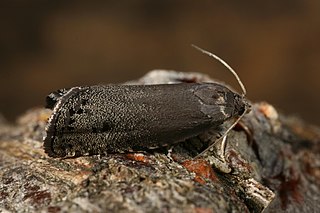
Cydia millenniana, the larch gall moth, is a moth of the family Tortricidae which galls larch. It is found from Europe to Russia and the Korean Peninsula.
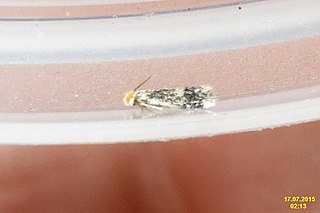
Ectoedemia hannoverella is a moth of the family Nepticulidae found in Asia and Europe. The larva mines the leaves of poplars causing a small gall in the petiole.

Monochroa cytisella is a moth of the family Gelechiidae and found in most of Europe. The larva feed in the stems of bracken causing a slight gall.
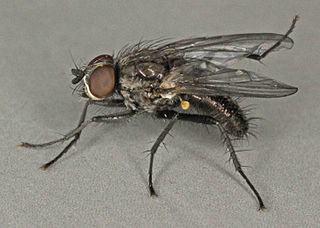
Chirosia betuleti is a species of fly, which causes knotting gall in ferns. The gall develops in the terminal shoots of ferns, such as broad buckler fern, male fern, lady fern, and ostrich fern.
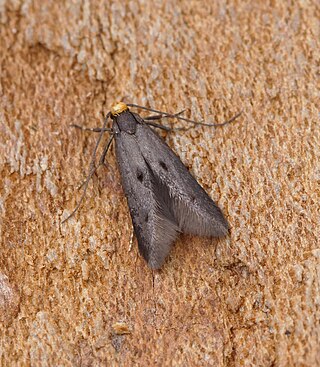
Spuleria is a genus of moths of the family Elachistidae. It contains only one species Spuleria flavicaput, which is found in most of Europe and Anatolia. The larvae mine the twigs of hawthorns.
Synanthedon flaviventris, the sallow clearwing, is a moth of the family Sesiidae. The larvae form pear-shaped galls on sallows.

Hartigiola annulipes is a species of midge fly in the family Cecidomyiidae, found in the Palearctic. The fly was first described by Theodor Hartig in 1839. The larvae gall the leaves of beech.

Rabdophaga salicis is a gall midge which forms galls on sallows. It was first described by Franz von Paula Schrank in 1803.
Dasineura auritae is a gall midge which forms galls on the leaves of sallows and their hybrids. It was first described by Ewald Heinrich Rübsaamen in 1916.
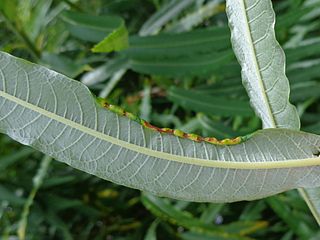
Rabdophaga marginemtorquens is a gall midge which forms galls on willows and is found in Europe. It was described by Johann Jacob Bremi-Wolf in 1847.

Iteomyia capreae is a gall midge which forms galls on willows. It was first described by Johannes Winnertz in 1853.
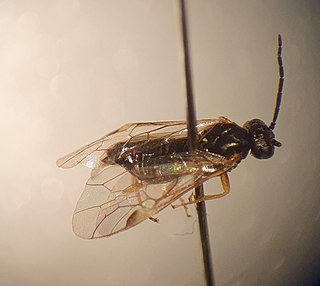
Euura proxima is a species of sawfly belonging to the family Tenthredinidae. The larvae feed on the leaves of willows, creating galls. It was described by Jean Guillaume Audinet-Serville in 1823. The species was placed in the genus Euura in 2014 and was previously known as Nematus proximus and Pontania proxima.
Euura bridgmanii is a species of sawfly belonging to the family Tenthredinidae. The larvae feed on the leaves of sallows. It was first described by the entomologist Peter Cameron in 1883.
Euura vesicator is a species of sawfly belonging to the family Tenthredinidae. The larvae feed internally in a gall on the leaves of purple willow and its hybrids. It was first described by Johann Jacob Bremi-Wolf in 1849.

Psychoides verhuella is a moth of the family Tineidae found in Europe. It was first described in 1853, by Charles Théophile Bruand d'Uzelle from a specimen from Besançon, France. It is the type species of the genus Psychoides, also raised by Charles Bruand in 1853. The larvae feed on ferns.

Profenusa thomsoni, the amber-marked birch leaf miner, is a species of sawfly in the family Tenthredinidae. It is native to the Palearctic realm but has spread to North America. The larvae feed on the foliage of birch trees.

Andricus inflator is a species of gall-forming wasps, in the genus Andricus, which has a sexual and an asexual generation, producing two different galls. The wasp was named by the German biologist Theodor Hartig, in 1840 and is found in Europe.

Celypha woodiana also known as the mistletoe marble is a moth of the family Tortricidae found in Europe. In Great Britain the moth is a priority species in the United Kingdom Biodiversity Action Plan. The species was described by Charles Golding Barrett who named it in honour of John Henry Wood.
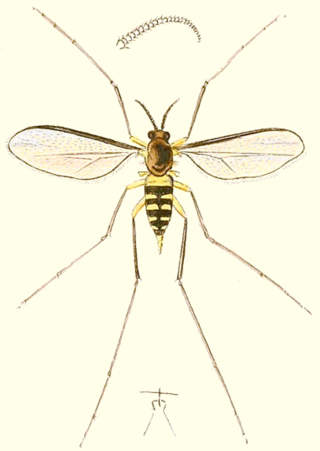
Lasioptera rubi is a species of gall midge in the family Cecidomyiidae and is found in Europe. It was first described in 1803 by the German priest, botanist and entomologist, Franz von Paula Schrank. The larvae feed within the tissue of brambles, creating abnormal plant growths known as galls.
Placochela nigripes is a gall midge which forms galls on the flower buds of elder, honeysuckle and privet. It was described by F Löw in 1877.















